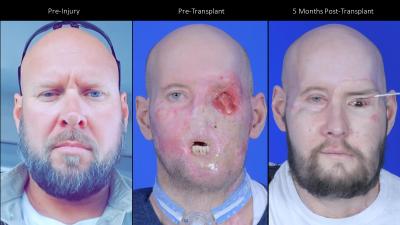In a world-first procedure earlier this year, a vast team of surgeons and OR staff at NYU Langone Health successfully performed a whole-eye and partial-face transplant on a man who had survived a potentially fatal electrical accident, the hospital announced this week.
Arkansas resident Aaron James, now 46, was working as a high-voltage lineman when he accidentally touched his face to a live wire in June 2021, triggering a 7,200-volt electric shock. Even after undergoing several reconstructive surgeries at a Texas medical center, he still lost his nose, lips, left eye, front teeth and parts of his left cheek and chin as well as much of his left arm.
The NYU Langone team helped advise throughout those procedures and began evaluating James for a face transplant a year after the accident. After deciding to move forward with both a partial face transplant and the first-ever whole-eye transplant, James was placed on the organ transplant list in February of this year and matched with an eligible donor within three months, allowing the procedure to take place in May.
The entire transplant project was led by Eduardo Rodriguez, M.D., director of the face transplant program and a professor of reconstructive plastic surgery at NYU Langone.

The process began May 27 and lasted around 21 hours—the entirety of which had been meticulously rehearsed in the months leading up to it. In addition to Rodriguez, it required a seven-person surgical team plus a broader OR team of 80 to simultaneously work on both James and the donor, with a total of more than 140 doctors, nurses and other clinicians having a hand in James’ care before, during and after the procedure.
The clinicians’ work was aided by technological support from Johnson & Johnson’s DePuy Synthes orthopedics business and Belgian 3D printing maven Materialise—the two of which have a long-standing partnership to produce 3D-printed titanium implants and other customized solutions for craniofacial surgeries.
The surgical team used the companies’ technologies to map out the procedure beforehand with 3D surgical planning software, then relied on 3D cutting guides personalized to James’ anatomy to ensure that the alignment of all bones, plates and screws was as precise as possible as they transferred over certain facial bones and tissues from the donor as well as his entire left eye, including the socket, orbital bones, optical nerve and all other surrounding tissues.
Though facial transplants have previously been completed, this marked the first time an eye was included in the procedure—and the first known whole-eye transplant at all.
James, a husband, father and military veteran, stayed at NYU Langone for only about six weeks after the procedure to recover, followed by two months of outpatient rehabilitation, and is now back at home in Arkansas. In the five months since, he hasn’t experienced any acute rejection episodes, according to the health system.
He currently can’t see out of the transplanted left eye, but, in a promising development, the organ has reportedly been able to receive direct blood flow to the retina, which is responsible for transmitting images to the brain to enable sight.
Doctors still aren’t sure whether that means James will one day be able to see out of the donated eye, especially since rebuilding the nerve connections between the eye and brain is a particularly challenging task. The surgical team injected donor-bone-marrow-derived adult stem cells into the optic nerve while transplanting the new eye in an attempt to encourage nerve repair and regeneration.
Still, Rodriguez noted in the release that even if it remains only a cosmetic benefit, the success of the procedure is still “a remarkable achievement.”
“The mere fact that we’ve accomplished the first successful whole-eye transplant with a face is a tremendous feat many have long thought was not possible,” he continued. “We’ve made one major step forward and have paved the way for the next chapter to restore vision.”
Steven Galetta, M.D., a neuro-ophthalmologist and professor and chair of neurology at NYU Langone, agreed, saying, “We’re now crossing into the frontier of the central nervous system. Whatever happens next allows the opportunity for various methods to try to enhance the remaining aspects of the retina, whether it be through growth factors, stem cells, or a device that can pick up the signals and then bypass things along that optic nerve pathway.”